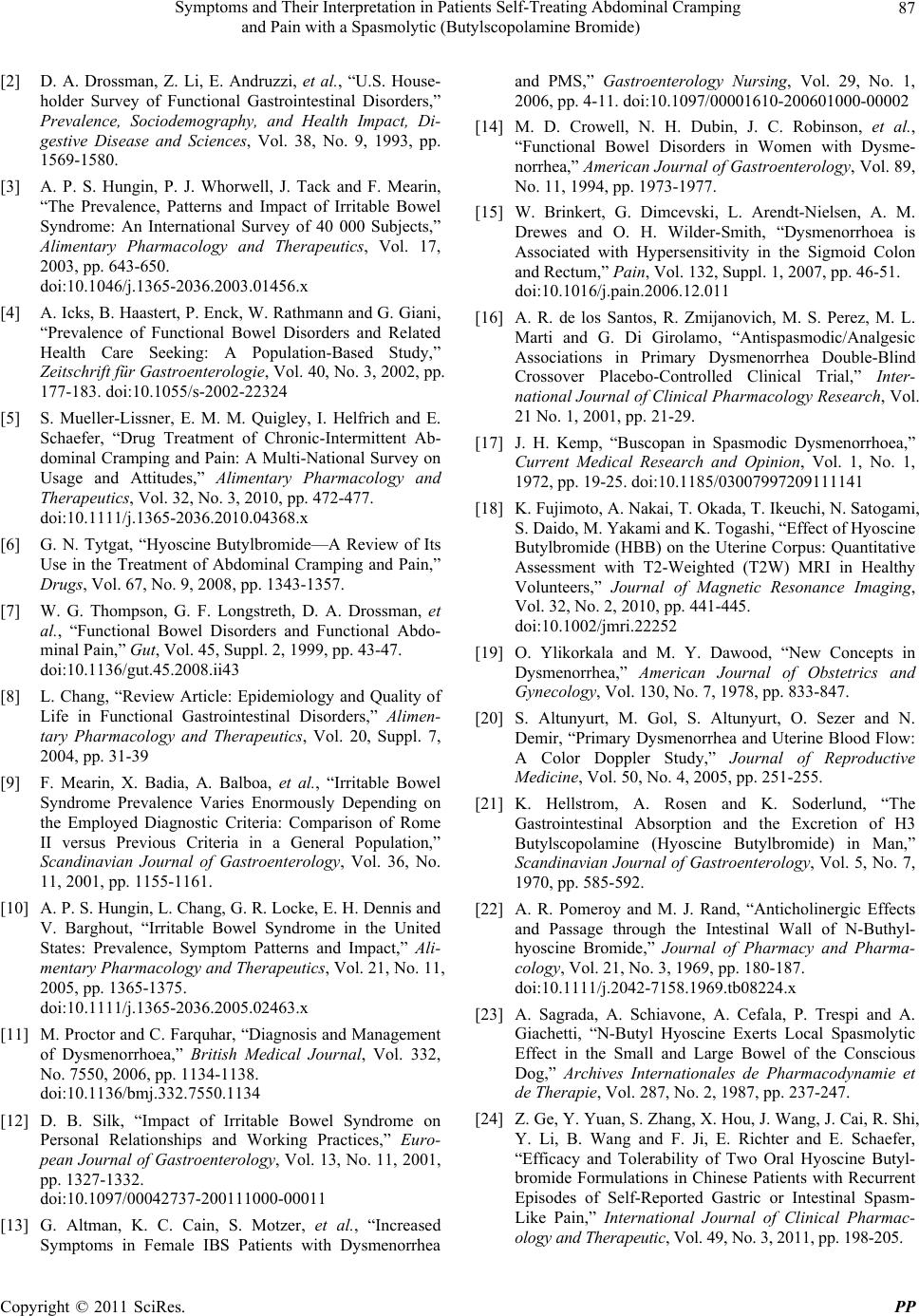
Symptoms and Their Interpretation in Patients Self-Treating Abdominal Cramping
and Pain with a Spasmolytic (Butylscopolamine Bromide)
Copyright © 2011 SciRes. PP
87
[2] D. A. Drossman, Z. Li, E. Andruzzi, et al., “U.S. House-
holder Survey of Functional Gastrointestinal Disorders,”
Prevalence, Sociodemography, and Health Impact, Di-
gestive Disease and Sciences, Vol. 38, No. 9, 1993, pp.
1569-1580.
[3] A. P. S. Hungin, P. J. Whorwell, J. Tack and F. Mearin,
“The Prevalence, Patterns and Impact of Irritable Bowel
Syndrome: An International Survey of 40 000 Subjects,”
Alimentary Pharmacology and Therapeutics, Vol. 17,
2003, pp. 643-650.
doi:10.1046/j.1365-2036.2003.01456.x
[4] A. Icks, B. Haastert, P. Enck, W. Rathmann and G. Giani,
“Prevalence of Functional Bowel Disorders and Related
Health Care Seeking: A Population-Based Study,”
Zeitschrift für Gastroenterologie, Vol. 40, No. 3, 2002, pp.
177-183. doi:10.1055/s-2002-22324
[5] S. Mueller-Lissner, E. M. M. Quigley, I. Helfrich and E.
Schaefer, “Drug Treatment of Chronic-Intermittent Ab-
dominal Cramping and Pain: A Multi-National Survey on
Usage and Attitudes,” Alimentary Pharmacology and
Therapeutics, Vol. 32, No. 3, 2010, pp. 472-477.
doi:10.1111/j.1365-2036.2010.04368.x
[6] G. N. Tytgat, “Hyoscine Butylbromide—A Review of Its
Use in the Treatment of Abdominal Cramping and Pain,”
Drugs, Vol. 67, No. 9, 2008, pp. 1343-1357.
[7] W. G. Thompson, G. F. Longstreth, D. A. Drossman, et
al., “Functional Bowel Disorders and Functional Abdo-
minal Pain,” Gut, Vol. 45, Suppl. 2, 1999, pp. 43-47.
doi:10.1136/gut.45.2008.ii43
[8] L. Chang, “Review Article: Epidemiology and Quality of
Life in Functional Gastrointestinal Disorders,” Alimen-
tary Pharmacology and Therapeutics, Vol. 20, Suppl. 7,
2004, pp. 31-39
[9] F. Mearin, X. Badia, A. Balboa, et al., “Irritable Bowel
Syndrome Prevalence Varies Enormously Depending on
the Employed Diagnostic Criteria: Comparison of Rome
II versus Previous Criteria in a General Population,”
Scandinavian Journal of Gastroenterology, Vol. 36, No.
11, 2001, pp. 1155-1161.
[10] A. P. S. Hungin, L. Chang, G. R. Locke, E. H. Dennis and
V. Barghout, “Irritable Bowel Syndrome in the United
States: Prevalence, Symptom Patterns and Impact,” Ali-
mentary Pharmacology and Therapeutics, Vol. 21, No. 11,
2005, pp. 1365-1375.
doi:10.1111/j.1365-2036.2005.02463.x
[11] M. Proctor and C. Farquhar, “Diagnosis and Management
of Dysmenorrhoea,” British Medical Journal, Vol. 332,
No. 7550, 2006, pp. 1134-1138.
doi:10.1136/bmj.332.7550.1134
[12] D. B. Silk, “Impact of Irritable Bowel Syndrome on
Personal Relationships and Working Practices,” Euro-
pean Journal of Gastroenterology, Vol. 13, No. 11, 2001,
pp. 1327-1332.
doi:10.1097/00042737-200111000-00011
[13] G. Altman, K. C. Cain, S. Motzer, et al., “Increased
Symptoms in Female IBS Patients with Dysmenorrhea
and PMS,” Gastroenterology Nursing, Vol. 29, No. 1,
2006, pp. 4-11. doi:10.1097/00001610-200601000-00002
[14] M. D. Crowell, N. H. Dubin, J. C. Robinson, et al.,
“Functional Bowel Disorders in Women with Dysme-
norrhea,” American Journal of Gastroenterology, Vol. 89,
No. 11, 1994, pp. 1973-1977.
[15] W. Brinkert, G. Dimcevski, L. Arendt-Nielsen, A. M.
Drewes and O. H. Wilder-Smith, “Dysmenorrhoea is
Associated with Hypersensitivity in the Sigmoid Colon
and Rectum,” Pain, Vol. 132, Suppl. 1, 2007, pp. 46-51.
doi:10.1016/j.pain.2006.12.011
[16] A. R. de los Santos, R. Zmijanovich, M. S. Perez, M. L.
Marti and G. Di Girolamo, “Antispasmodic/Analgesic
Associations in Primary Dysmenorrhea Double-Blind
Crossover Placebo-Controlled Clinical Trial,” Inter-
national Journal of Clinical Pharmacology Research, Vol.
21 No. 1, 2001, pp. 21-29.
[17] J. H. Kemp, “Buscopan in Spasmodic Dysmenorrhoea,”
Current Medical Research and Opinion, Vol. 1, No. 1,
1972, pp. 19-25. doi:10.1185/03007997209111141
[18] K. Fujimoto, A. Nakai, T. Okada, T. Ikeuchi, N. Satogami,
S. Daido, M. Yakami and K. Togashi, “Effect of Hyoscine
Butylbromide (HBB) on the Uterine Corpus: Quantitative
Assessment with T2-Weighted (T2W) MRI in Healthy
Volunteers,” Journal of Magnetic Resonance Imaging,
Vol. 32, No. 2, 2010, pp. 441-445.
doi:10.1002/jmri.22252
[19] O. Ylikorkala and M. Y. Dawood, “New Concepts in
Dysmenorrhea,” American Journal of Obstetrics and
Gynecology, Vol. 130, No. 7, 1978, pp. 833-847.
[20] S. Altunyurt, M. Gol, S. Altunyurt, O. Sezer and N.
Demir, “Primary Dysmenorrhea and Uterine Blood Flow:
A Color Doppler Study,” Journal of Reproductive
Medicine, Vol. 50, No. 4, 2005, pp. 251-255.
[21] K. Hellstrom, A. Rosen and K. Soderlund, “The
Gastrointestinal Absorption and the Excretion of H3
Butylscopolamine (Hyoscine Butylbromide) in Man,”
Scandinavian Journal of Gastroenterology, Vol. 5, No. 7,
1970, pp. 585-592.
[22] A. R. Pomeroy and M. J. Rand, “Anticholinergic Effects
and Passage through the Intestinal Wall of N-Buthyl-
hyoscine Bromide,” Journal of Pharmacy and Pharma-
cology, Vol. 21, No. 3, 1969, pp. 180-187.
doi:10.1111/j.2042-7158.1969.tb08224.x
[23] A. Sagrada, A. Schiavone, A. Cefala, P. Trespi and A.
Giachetti, “N-Butyl Hyoscine Exerts Local Spasmolytic
Effect in the Small and Large Bowel of the Conscious
Dog,” Archives Internationales de Pharmacodynamie et
de Therapie, Vol. 287, No. 2, 1987, pp. 237-247.
[24] Z. Ge, Y. Yuan, S. Zhang, X. Hou, J. Wang, J. Cai, R. Shi,
Y. Li, B. Wang and F. Ji, E. Richter and E. Schaefer,
“Efficacy and Tolerability of Two Oral Hyoscine Butyl-
bromide Formulations in Chinese Patients with Recurrent
Episodes of Self-Reported Gastric or Intestinal Spasm-
Like Pain,” International Journal of Clinical Pharmac-
ology and Therapeutic, Vol. 49, No. 3, 2011, pp. 198-205.